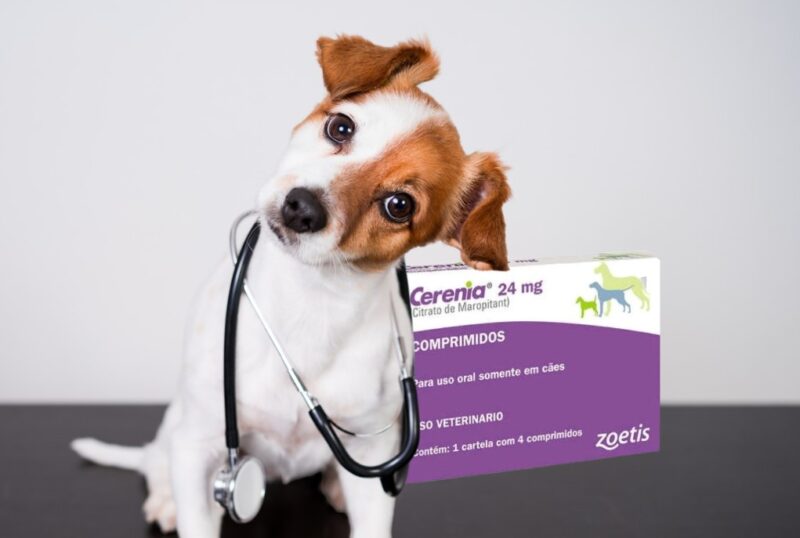
-
 Jane Harmon
Jane Harmon
- Published:
- Updated: March 12, 2024
- Category: Dog Specific Care, Medication and Treatments, Pet Health and Care
Share Post:
In any discussion that involves the health of our little friends, it’s crucial to remember that every medication, no matter how benign it might seem, carries a certain degree of risk. Each dog is an individual and can react differently to the same medication.
This principle holds true for Cerenia as well. When used appropriately and under the guidance of a veterinarian, the medication is generally considered a safe and effective treatment for certain conditions. However, like any other drug, it can cause adverse effects in some animals.
These potential side effects, their frequency, severity, and how they can be managed will be our primary focus in this discussion.
Does Its Consumption Lead to Death?

The question at the heart of our discussion is whether Cerenia can cause death in dogs. This is a serious and often distressing concern for many pet owners, and it’s important to approach it with care, considering all available research and evidence.
Evidence and Research
Based on the current scientific literature, there is no definitive evidence to suggest that this medication can directly cause death in dogs. Most adverse reactions reported are relatively mild and short-lived, with serious side effects being rare.
While there are a few reported cases of severe reactions or complications related to the use of this medication, these instances are usually associated with an overdose or underlying health conditions.
Putting It in Perspective
While it’s essential to be aware of potential risks, it’s equally important to put these risks in context. Cerenia, when used correctly and under the guidance of a vet, is generally considered safe.
It has a proven track record in improving a dog’s quality of life by managing conditions that could otherwise cause significant distress and discomfort. As with any medication, it’s important to consider your pet’s unique health circumstances and weigh the benefits against potential risks.
Always consult with your vet before starting any new medication, and monitor your pet closely while they’re on the medication.
Cerenia: The Basics

To fully understand the potential risks and benefits of a drug, it’s vital to comprehend what the drug is, how it works, and what it is typically used for.
What Is Cerenia?
Cerenia is a drug classified as a neurokinin-1 (NK1) receptor antagonist. This means it works by blocking the effects of neurokinin-1, a specific type of receptor found in a dog’s brain. These NK1 receptors are activated by a compound called substance P, a key player in the body’s emetic (vomiting) reflex.
Substance P is a neuropeptide, a type of chemical messenger that transmits signals in the brain. When the medication enters a dog’s system, it targets these NK1 receptors and effectively blocks them. This blocking action prevents substance P from binding to these receptors and initiating the cascade of events that ultimately leads to vomiting.
Typical Uses
Veterinarians commonly prescribe Cerenia for managing acute vomiting in dogs and preventing vomiting caused by motion sickness. It’s particularly useful for dogs that suffer from car sickness, making travel much more comfortable for them.
Additionally, this medication can also help manage nausea and vomiting associated with some chemotherapy drugs used in cancer treatment, thereby greatly increasing the quality of life for dogs undergoing such treatments.
While this can be a real boon for dogs prone to car sickness or those undergoing chemotherapy, it’s important to note that it’s not a one-size-fits-all solution. Its usage should be guided by a veterinarian and depends on the specific needs and health status of your dog.
Understanding when and how to use this medication is crucial to minimize potential risks and maximize its benefits.
Possible Side Effects of Cerenia

As with any medication, Cerenia may cause side effects in some dogs. Some of these side effects are common and relatively mild, while others are less common but more severe. In this section, we’ll discuss both types of side effects and provide some insights into how to handle them.
Common Side Effects
The most common side effects reported in dogs taking Cerenia include lethargy, drooling, and lack of appetite. Some dogs may also experience loose or runny stools, often referred to as diarrhea, while others may show signs of discomfort or pain at the injection site if Cerenia was administered intravenously.
These side effects are generally mild and often resolve on their own, but it’s still important to pay close attention to your pet’s behavior and overall well-being while they’re on the medication. If your dog experiences these side effects persistently or they appear to worsen, it’s essential to contact your veterinarian immediately.
Less Common Side Effects
In rare cases, some dogs might experience more severe side effects from taking Cerenia. These can include intense abdominal pain, diarrhea containing blood, or signs of an allergic reaction. Allergic reactions might present as facial swelling, development of hives, or difficulty breathing.
Although these severe side effects are not common, they are serious and warrant immediate veterinary attention. If your dog shows any of these signs after taking Cerenia, you should seek veterinary help right away. Prompt action can help ensure your pet’s safety and well-being.
Overdose

Overdosing on any medication can be hazardous, and Cerenia is no exception. In this section, we’ll discuss the potential implications of a Cerenia overdose, how to recognize the signs of an overdose, and what steps you should take in response.
Signs of Overdose
The signs of a Cerenia overdose in dogs can vary widely but often include severe lethargy, lack of coordination, or difficulty standing. Some dogs may exhibit excessive drooling, a rapid heart rate, or fluctuations in body temperature, which could indicate fever or hypothermia.
These signs could indicate a serious condition that requires immediate veterinary attention. If your pet shows any of these signs after taking the medication, it’s crucial not to delay seeking veterinary help. An overdose is a medical emergency that requires prompt action.
What to Do in Case of Overdose?
If you suspect that your dog has overdosed on the medication, the first step is to contact your veterinarian or a local emergency veterinary hospital immediately.
When you reach out to a vet, try to provide them with as much information as possible, such as how much medication your dog ingested, when the ingestion occurred, and any symptoms your dog might be showing.
Time is of the essence in such situations, and the faster your pet receives medical attention, the better their chances of recovery. Quick and appropriate action can help mitigate the risks associated with an overdose and can potentially save your dog’s life.
Long-Term Use of The Medication

Impact on Dog’s Health
While the exact effects of long-term Cerenia use in dogs are still under investigation, some studies suggest potential risks. For instance, some dogs may develop liver issues, while others might experience changes in their blood cell counts.
These changes could potentially lead to conditions like anemia or a decreased ability to fight infections. These findings highlight the need for regular monitoring when using Cerenia for extended periods. Regular vet check-ups can help catch any potential problems early and ensure your dog’s safety and well-being.
Considerations for Long-Term Use
If your dog needs to be on Cerenia for a prolonged time, your vet may recommend regular blood tests and check-ups to monitor for any potential side effects. It’s crucial to adhere to these appointments, as they can help your vet detect any issues early and take necessary action promptly.
Balancing the benefits of long-term Cerenia use against its potential risks is a delicate act that requires the guidance of a professional. By working closely with your vet, you can ensure that your dog benefits from the medication while minimizing any potential risks.
FAQs

Can Cerenia Be Given with Other Anti-Nausea Medications?
It should not be given with other anti-nausea medications without consulting a veterinarian first.
How Should the Medication Be Stored?
Store it according to the manufacturer’s instructions, and keep it out of reach of pets and children.
Are There Any Specific Liver or Kidney Concerns with Its Use?
The medication should be used with caution in dogs with known liver or kidney issues, and proper monitoring may be necessary.
Is Cerenia Safe to Use with Senior Dogs?
Yes, this medication can be used with senior dogs, but the dosage may need adjustment based on their health status.
Can It Be Used to Prevent Motion Sickness During Travel?
Yes, Cerenia can be used to prevent motion sickness during travel.
Conclusion
It’s essential to remember that while all medications carry risks, the risk of serious side effects or death from Cerenia is relatively low when used correctly. As a pet owner, your role is to stay informed, consult with your vet regularly, and closely observe your dog for any changes in behavior or health.
It’s always better to err on the side of caution and reach out to your vet if anything seems out of the ordinary. With the right approach, this medication can continue to be a valuable tool for managing vomiting in dogs, improving their lives and overall well-being.
Related Posts:











